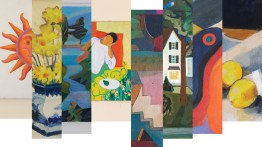A Life in Art Entwined: Works by Joan and Reynold Ruffins A’51
POSTED ON: March 1, 2023

The Cooper Union is currently hosting a new exhibition of works by artists Joan Ruffins (1932–2013) and Reynold Ruffins (1930–2021). This campus exhibition runs from Fall 2022 to Spring 2023 in the Stuyvesant-Fish House and is available for viewing by request. To schedule a visit, please contact Fabian Gonzalez at fabian.gonzalez@cooper.edu.
An online gallery of exhibition photos can be viewed here.
A 1951 School of Art graduate and founding member of the legendary Push Pin Studios, Reynold Ruffins was a pioneering graphic designer, illustrator, and artist. As a young Black man in the pre-Civil Rights-era advertising world, Ruffins broke the Madison Avenue color barrier working for William Douglas McAdams, the pharmaceutical ad agency. Over his long career, he created designs and illustrations for publications like The New York Times Magazine, Time, Life, Fortune, Gourmet, and Essence magazines. Ruffins co-illustrated his first children’s book, The Amazing Maze, in 1969, and went on to illustrate nearly 20 more.
Commissions for an array of clients—Amtrak, AT&T, Coca-Cola, CBS, IBM, Pfizer, Scribners, Random House, and the U.S. Post Office—have garnered many awards, including from the New York Art Directors Club and The Society of Illustrators. His work has been acclaimed in trade and design publications and internationally recognized in group show exhibitions at the Louvre in Paris, as well as in Milan, Bologna, and Tokyo. In 2022 he was inducted into the Society of Illustrators Hall of Fame. He received the Augustus St. Gaudens Award for outstanding professional achievement in arts from The Cooper Union as well as The Cooper Union Presidential Citation for his work and prominence in his profession.
Ruffins taught for more than a decade at Queens College CUNY in addition to teaching at the School of Visual Arts, the Parsons School of Design at the New School, and Syracuse University. After his accomplished career as an illustrator, designer, and educator, Reynold began painting full time, creating joyous, jazzy, and often abstract work that he exhibited in Sag Harbor and elsewhere.
Joan Young Ruffins’ path as an artist is not as well-documented or widely known as that of her husband, Reynold, though he would say she was arguably the more talented painter. Joan Ruffins attended The Cooper Union from 1952 to 1954. In a sign of the times, Joan was asked to leave the college when she became pregnant. The dean at the time told her that she was wasting a spot that could be given to a man. Decades later, the school awarded her a certificate of completion.
By choice and by circumstance, family was most important to Joan. Upon being asked to leave Cooper she raised her four children, teaching them and the neighborhood kids art in the basement of their Queens home. Her drawings and paintings, often evocative of time and place, have been characterized as primitive at times, and yet there is a veracity of emotion to her work that speaks to her lived experience, largely in the more domestic realms. Other pieces depict life and landscapes from nature and Sag Harbor.
Read more about Joan and Reynold Ruffins in the exhibition catalogue, with artist biographies written by Deborah Ruffins, wife of Ben Ruffins, on behalf of Todd Ruffins, Lynn Ruffins Cave, and Seth Ruffins, Joan and Reynold Ruffins’ children.
This exhibition was organized by Adriana Farmiga A’96, associate dean and adjunct professor in the School of Art, and Yuri Masnyj A’98, adjunct professor in the School of Art, in coordination with the Office of the President of The Cooper Union.




